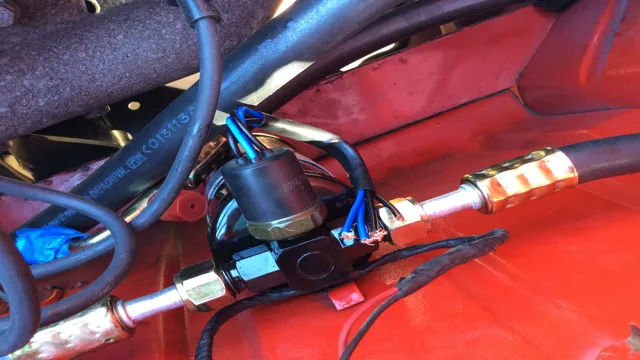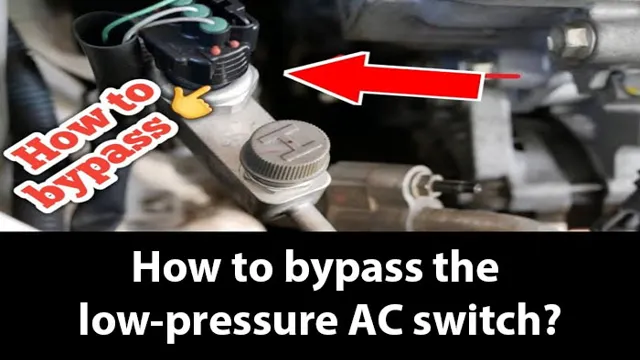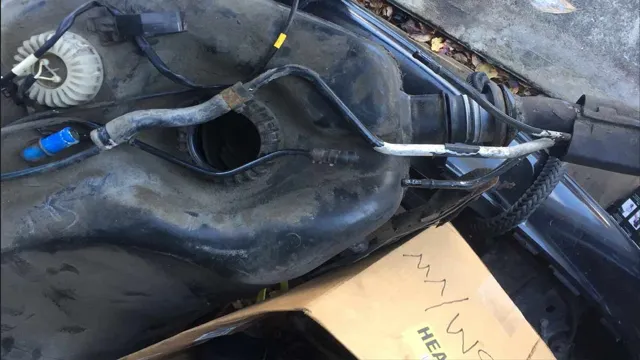Foolproof Ways to Bypass Your AC Low Pressure Switch!
Are you looking for ways to bypass the AC low pressure switch? You may find yourself in this situation if your air conditioning unit is not working correctly. The AC low pressure switch is responsible for preventing damage to your air conditioning system by shutting it off when the refrigerant level drops too low. However, if the switch is faulty, your system won’t cool effectively or may not even turn on.
This can be frustrating, especially during hot summer months. Luckily, there are a few solutions to bypassing the AC low pressure switch that we will explore in this blog post, so you can get your air conditioning system back up and running in no time. Let’s dive in!
Understanding the AC low pressure switch
If you’re here wondering how to bypass the AC low pressure switch, it’s essential to first understand what it does and why it’s necessary. The low pressure switch is a safety feature in your air conditioning system designed to prevent damage to the compressor by shutting down the system when the refrigerant pressure drops below a specified level. Without the switch, continued operation of the AC system can lead to costly repairs or even replacement.
While bypassing the low pressure switch may seem tempting to get the cold air flowing again, it’s not recommended to tamper with it. Instead, it’s best to diagnose the problem and make necessary repairs to restore your AC system’s normal operation. If you’re unsure of how to proceed, it’s always best to seek the help of a professional HVAC technician.
What is it and why is it important
The AC low pressure switch is an essential component of your car’s air conditioning system. It is responsible for monitoring the pressure of the refrigerant in the AC system and protecting it from damage. When the pressure drops below a specific set point, it triggers the switch to turn off the compressor and prevent the system from operating further.
If ignored, it can cause damage to the compressor, which can result in costly repairs. Therefore, it’s crucial to pay attention to the warning signs, such as weak airflow or warm air, and take your car for an AC inspection. A faulty low-pressure switch can also lead to a complete system failure, which can be uncomfortable and inconvenient, especially during hot summer days.
So, it’s always better to take preventative measures, like routine AC maintenance, to avoid problems in the long run.

Symptoms of a faulty low pressure switch
If you’re experiencing problems with your car’s AC system, there’s a chance that the low pressure switch could be to blame. This important component is responsible for monitoring the pressure of the refrigerant in your system, and shutting it off if it falls below a certain level. If the switch is faulty, you might notice a number of symptoms, such as your AC system not blowing cold air, or the compressor not turning on at all.
Additionally, your system might cycle on and off rapidly, or produce strange noises when it’s running. If you suspect that your low pressure switch is the culprit, it’s important to have it inspected and replaced as soon as possible to avoid further damage to your AC system. Remember to get your car serviced on a regular basis to prevent such problems in future.
Bypassing the AC low pressure switch
If your AC unit is not producing cool air, it could be due to a malfunctioning low pressure switch that prevents the compressor from operating. Luckily, you can bypass the switch to determine if it is the root of the problem. The first step is to locate the low pressure switch, typically located on the AC compressor or receiver-drier.
Next, you’ll want to remove the switch from its wiring harness and use a jumper wire to connect the two terminals together. This effectively bypasses the switch, allowing the compressor to engage and the AC unit to produce cold air. However, it’s important to note that bypassing the low pressure switch is only a temporary solution, and a properly functioning switch is necessary for the safe and efficient operation of your AC system.
If you suspect the switch is faulty, it’s best to have a professional diagnose and replace it.
Tools needed and safety precautions
When bypassing the AC low pressure switch, ensure that you have the necessary tools and take safety precautions to avoid accidents. You’ll need a jumper wire or a fuse to connect the switch, a voltmeter to test the circuit, and a refrigerant recovery machine to remove the refrigerant from the system. Always refer to the vehicle’s manual for specific instructions and diagrams before attempting any work.
Safety goggles and gloves are essential to avoid getting any refrigerant or oil on your skin or eyes and to protect against electrical shock. Remember to discharge the capacitor before touching any electrical components and to disconnect the battery to avoid any accidental current flow. With the necessary tools and safety precautions in place, you can safely bypass the AC low pressure switch and restore your air conditioning system’s function.
Remember, however, that bypassing the switch is a temporary solution and should only be used in emergencies. It’s crucial to address and fix the underlying issue as soon as possible to prevent further damage to your AC system.
Step-by-step instructions for bypassing
Bypassing the AC low pressure switch is a helpful solution if your AC is not functioning correctly. While it’s not recommended to bypass any safety device, it is always better to have an air conditioner working efficiently during hot summer days. Here’s a step-by-step guide on how to bypass the AC low pressure switch.
First, locate the AC low pressure switch, which is usually located on the accumulator. Next, unplug the switch connector, and unscrew the switch assembly. Afterward, remove the valve core from the service port and insert a jumper wire between the two terminals.
This wire will act as a bridge between the switch connector pins, thereby bypassing the pressure switch. Finally, replace the valve core and reassemble the switch. However, it’s important to remember that bypassing the low-pressure switch disables a crucial safety feature of the AC system, which alerts the driver when the refrigerant levels are low.
Therefore, bypassing the switch should only be a temporary solution, and you should have the system checked by a professional technician immediately.
Testing the system after bypassing
After bypassing the AC low pressure switch, it is important to test the system to ensure that it is functioning properly. One way to do this is to check the system’s pressure readings. The bypassed switch may cause the pressure to be too high, which can damage the system.
Therefore, it is essential to use a pressure gauge to check if the pressure is within the safe range. Another way to test the system is to check if the compressor is running. By turning on the AC, the compressor should engage and start running.
If the compressor fails to start, it may indicate a problem with the bypassed switch. It is important to note that bypassing the switch should only be done for troubleshooting purposes and not as a permanent solution. Keeping the switch bypassed for an extended period can damage the system and compromise its performance.
Regular system maintenance should be performed to prevent future issues.
Alternatives to bypassing the AC low pressure switch
If you’re looking to bypass the AC low pressure switch in your car, there are actually a few alternative solutions that you can pursue. Firstly, you might consider simply replacing the switch altogether. This can usually be done relatively easily, and will not only solve your current issue but also ensure that your AC system is functioning optimally in the future.
Alternatively, you could try adding a jumper wire to the connector on the switch. This will effectively bypass the switch, but without permanently altering the wiring of your car. However, do keep in mind that jumping the switch should only be a temporary fix, as it may result in the system becoming damaged.
If neither of these options seem feasible, you could also consider installing an AC pressure bypass switch instead. This will allow the compressor to continue running regardless of the pressure within the system, ensuring that your car stays cool even in less than optimal conditions. Ultimately, the specific solution that will work best for you will depend on a variety of factors, including the make and model of your car, the severity of the issue, and your own personal preferences.
Whatever you choose, be sure to consult with a professional mechanic before making any modifications to your AC system.
Repairing or replacing the low pressure switch
If your car’s AC system is acting up, it’s important not to take shortcuts that could cause more damage in the long run. Bypassing the low pressure switch might seem like a quick and easy fix, but it could lead to serious problems down the road. Instead, it’s better to consider repairing or replacing the switch.
However, before you do that, there are a few alternative options to try. One approach is to check the amount of refrigerant in your system. If it’s low, adding more might solve the problem and eliminate the need for switch repair.
Another possibility is to check the compressor clutch. If it’s not functioning properly, it could be the root of the problem. In any case, it’s always best to consult with a certified technician before attempting any repairs on your own.
Take the time to weigh all your options and choose the one that’s right for you. Your car and your budget will thank you in the end.
Consulting a professional technician
If you’re considering bypassing the AC low pressure switch in your car, it’s important to understand that this is never recommended. There are several reasons why your AC system may be low on refrigerant, and bypassing this safety feature will not solve the underlying issue. Instead, you should consult with a professional technician who can diagnose the problem and recommend the appropriate solution.
Some potential alternatives to bypassing the low pressure switch include repairing any leaks in the system, replacing damaged components, or recharging the refrigerant. These options may not be as quick or cheap as bypassing the switch, but they will help ensure that your AC system is functioning safely and effectively. Ultimately, taking the time to properly maintain your AC system can save you time, money, and hassle in the long run.
So before you decide to bypass any of your car’s safety features, it’s best to consult with a professional and get their expert opinion on the matter.
Final thoughts and cautions
While it is possible to bypass the AC low pressure switch, it should not be done without caution. If the switch is tripping, it is likely due to a malfunction or inadequate refrigerant levels, which can cause damage to the system. Bypassing the switch can temporarily solve the problem, but it is essential to address the underlying cause as soon as possible to prevent further damage.
Additionally, attempting to bypass the switch without proper knowledge and equipment could be dangerous and potentially cause harm to oneself or the AC system. It is always best to consult with a professional HVAC technician to diagnose and fix any issues with the system. So, while bypassing the AC low pressure switch may seem like a quick fix, it is important to proceed with caution and address the root cause of the issue to ensure a fully functioning and safe AC system.
Conclusion
In conclusion, we do not recommend bypassing the AC low pressure switch as it is a crucial safety feature that prevents damage to your compressor and refrigerant system. However, if you absolutely need to bypass it, the internet is full of risky and unreliable hacks. Our advice? Leave it to the professionals and enjoy a perfectly functioning AC system without any unnecessary risks or consequences.
“
FAQs
What is an AC low pressure switch?
An AC low pressure switch is a safety device that senses when the refrigerant pressure in an air conditioning system drops below a certain level and shuts down the compressor to prevent damage.
What are the symptoms of a faulty AC low pressure switch?
Symptoms of a faulty AC low pressure switch include the AC system failing to turn on, the compressor cycling on and off rapidly, and the AC system blowing warm air.
Can you bypass an AC low pressure switch?
It is possible to bypass an AC low pressure switch, but it is not recommended as this can lead to further damage to the AC system and potential safety risks.
How do you troubleshoot an AC low pressure switch?
To troubleshoot an AC low pressure switch, you can use a multimeter to test the continuity of the switch and ensure that there is adequate refrigerant in the system. If the switch is faulty, it may need to be replaced.






